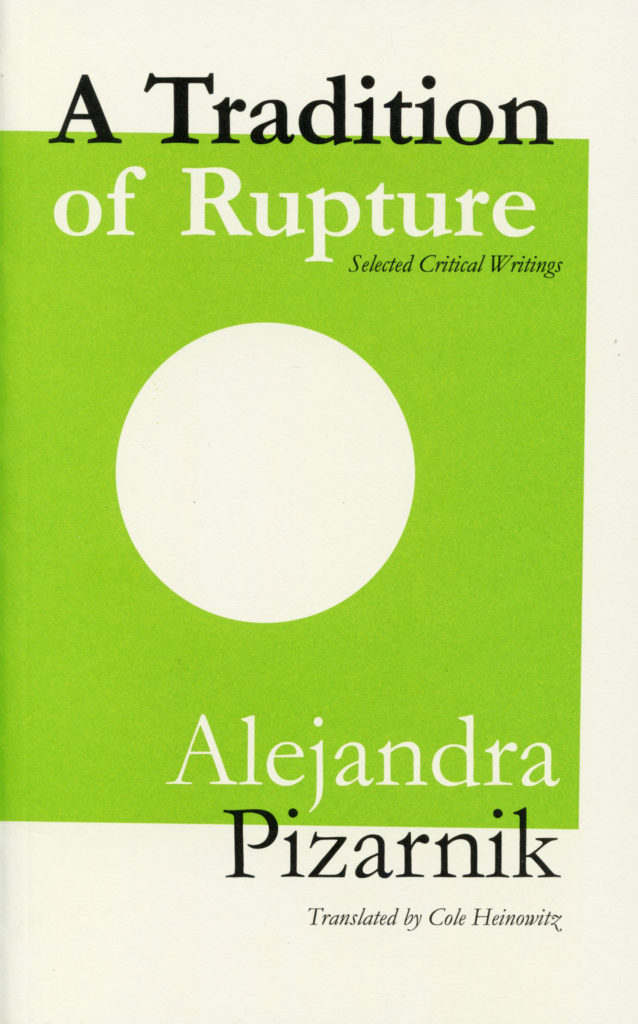For many years now we have known Alejandra Pizarnik as a poet who explored the mysteries of pain & mental suffering in a mode & at a level like that, say, of Kafka, & still more that of Artaud. What her translator Cole Heinowitz now brings us so forcefully is a sampling of Pizarnik’s poetics & critical writings, as a further & necessary record of what it means to claim a life through poetry. Simultaneously subversive & tragic, hers is a full-blown work that cries for our attention.
Jerome Rothenberg
Too often translations into American English reinforce a certain image that reinstates the generic authenticity of “poet” or “novelist,” while leaving out the much wider ground on which a writer’s work is based. Alejandra Pizarnik is a classic case in point: despite more of her poetry now available in translation, very little gestures beyond the established image of the “tormented” poet to offer what Cole Heinowitz, in her deeply informed, judiciously selected, and pitch-perfectly rendered collection, calls a “complementary yet strikingly distinct view of Pizarnik—that is, of the poet as critic.” Thanks to this work, we can finally see Pizarnik as not just the extraordinary poet she was but as a thinker, constantly creating a poetics to come to terms with her own time, place, circumstance, and unyielding vision.
Ammiel Alcalay
In the Western literary tradition, a large number of poets have written literary and aesthetic essays parallel to poetry: Schiller, Valéry, Baudelaire, Mallarmé, Vallejo, Lezama Lima, Octavio Paz, among many others. Few women intervened within such tradition. In the case of Latin America, Gabriela Mistral and Rosario Castellanos are two paradigmatic figures in the twentieth century, as they wrote short pieces that were published in newspapers, outside the main journals or in collected books. In a sense, Pizarnik represents a unique writer for intervening within a male dominated tradition. As essayist she reveals her habits as a poet, offers illuminating analysis (for example on Artaud), and her words are electrifying. Her essays and poetry also demonstrate a coherent, productive and symbiotic relationship. When she says “Poetry is where everything happens,” essays also happen within such a realm. I am wondering, however, if one can also read her essays against such a canonical tradition, paying attention to her nuances and the way she converses with the poetic authorities, opening meaningful spaces to her voice? This volume of Cole Heinowitz's masterful translations of Pizarnik’s writings allows such an electrifying experience and critical consideration.
Rubén Medina
Even if you don’t know any of the authors (mostly poets) whom Alejandra Pizarnik examines in this book, you will want to know her, for we have much to learn about “poetic inquiry” from this rigorous Argentine writer who attempted the unprecedented: to precisely define the practically indefinable tensions that gravitate between words and silence in each movement of a poet’s particular discourse. You will be seduced, I assure you, by the unexpected depth of this (new) gaze that breaks through a surprisingly respectful analysis of what is there, interwoven in the language that has managed to express itself, and whose message is now received by one who was herself a poet, as well as a Jew and a lesbian—that is, a triply-exiled woman who chose to write from the irrevocable position of imperative marginality which is the necessary home of a gaze, such as hers, that asks only to see: “please, let there be no look that does not see.” Her reviews and prologues refuse to “flatter the most facile sentiments” and therefore aid us in the effort of learning to “reread, but now with one’s heart,” that is, to read “openly.” Thanks to Cole Heinowitz, we can now access the critical voice of Alejandra Pizarnik, that voice which meticulously guides us through the kingdom where “the impossible becomes possible.” And, what is more, the reader interested in Pizarnik’s poetry will find testimonies here of her personal writing rituals, rituals that are essential to understanding this alluring figure of Latin American letters.
Claudia Kerik
